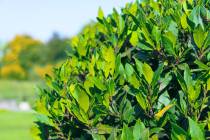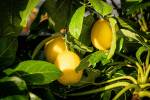Shade, water add up to make powdery mildew
Q: I have a 5-year-old Thompson grape that was a great producer for the last four years. Last year, the grape leaves had a white "dust" on them, the grapes were small, and some did not ripen at all. What should I do now? Any hope?
A: Most likely, this was a fungal disease called powdery mildew, which is common on grapes during wet weather or regions of the country with high humidity.
This is common, particularly in grapes, if they are grown in some shade and if the leaves or grape bunches remain wet for a number of hours. We had a wet spring this past year, and that could be part of the problem. If there was shade on the vines or they were very dense, then this would add to the problem.
Powdery mildew of grapes is also a problem if there is not enough air movement through the vine or past the bunches so they dry. It is best if the vine is growing in full sun. Bunches of grapes should hang in the open air where there is plenty of air movement.
Leaves should not be covering one another; they need air movement to dry out. This disease can be prevented if the vine is in full sun and pruned so it is less dense and there is plenty of air movement.
Watch for this disease again if we have a wet spring like we did last year. Dusting the vine and bunches with sulfur or lime sulfur fungicide helps keep the disease from spreading.
An old-fashioned spray called Bordeaux also works if applied as soon as this white dust is seen. You might also consider Neem oil as an organic alternative. But it is best to make sure the vine is in full sun, and there is plenty of air movement through it.
Q: Last year, our olive tree had lots of fruit, but it was very messy. Can you tell me when we should spray the tree to keep it from fruiting next time?
A: Olive flowering peak is around mid-April. The usual homeowner chemicals are Olive Stop and Florel Fruit Eliminator. They work a bit differently.
Florel can be applied once before the flowers open, but Olive Stop must be applied two or three times while the flowers are open. Timing for sprays is when flowers are first opening, again when most are open and a third time when the late ones are opening.
The spray schedule for Olive Stop can last up to two weeks depending on air temperatures. Cooler weather causes flowers to open more slowly than hotter weather. This causes our spray season for fruit control to be longer.
For flower and pollen control, Florel is probably a better choice, but it is a bit more toxic to the trees than Olive Stop. For just fruit control, Olive Stop is fine. Any plants beneath the trees should be sprayed with water immediately after these chemicals are applied to remove what falls on the leaves and minimize any damage from the spray.
With Olive Stop, the chemical has to reach the flowers as much as possible. This is not necessary with Florel. Watch for sales on these products as we get closer to April.
Commercial applicators have a little bit more flexibility because they can use products that you can't. They have products called Embark and Maintain, which are different from homeowner products.
Remember that olives coming from trees that have been sprayed should not be used for human consumption.
Q: I seem to have grubs in one area of the planting areas around the house. What do you recommend to eradicate grubs? I have roses and a few ornamentals in these beds.
A: For long-term control, I would like you to consider beneficial nematodes. Beneficial nematodes will not hurt your plants, yourself or your pets, but they can give you long-lasting control of grubs for many years.
Look for them locally at your nursery or garden center, or you can purchase them at online. You can apply it now, but it is best when the temperatures are warm; otherwise, you are faced with applying conventional pesticides as a soil drench around your plants at this time of the year.
Q: Can spraying micro-nutrients, such as iron, on fruit tree leaves cause bacterial leaf spot to form or spread? I had problems with bacterial leaf spot on my nectarine trees in the past. Last year, the leaves weren't affected as much. I don't want the pathogen to spread again.
A: Where do you live? Who made this diagnosis? I have not heard of bacterial leaf spot forming in the dry desert. In more humid climates, it can be more common. The leaf spots on leaves should be surrounded by a yellow halo if it is bacterial leaf spot.
Bacterial infections usually require wet or humid environments and warm to hot temperatures or insects to spread the disease. And these wet or humid environments must be present over a long enough period of time, usually many consecutive hours.
It would be possible for this disease to be present if plants are crowded together or very dense so that the leaves cannot dry or there is no air movement to dry them. This last spring, which was very wet, might have contributed to this disease. Overhead irrigation, such as sprinklers, could also contribute to a problem.
However, there should be no problem if you apply micro-nutrient sprays to the leaves early in the morning so the leaves can dry before nightfall. Spray early in the season as soon as you see spots developing on leaves.
The pathogen or bacteria are already present on stems and move to the foliage early in the spring. The leaves just need the right environment (temperature and humidity or degree of wetness) to cause infection.
It also helps if the canopy is not dense so there is air movement to help dry the leaves. Prune so that you create enough space between branches to allow some sunlight to penetrate inside the canopy, dry the leaves and reduce shading.
There are not many pest control products for bacterial diseases, but a fairly common fungicide such as Bordeaux or the copper fungicides can give your plants some good protection if applied when temperatures get warm.
Q: I was reading your blog about peach tree borer, and I am planning to buy some pheromone traps. Which traps and lures should I buy?
A: Pheromone traps can be very effective at detecting and removing some pests that attack fruit trees or their fruit. However, there are not pheromone traps for every pest. Pheromone traps are highly selective and very effective at luring a specific pest to the trap where it is stuck to a very sticky surface. You must be 100 percent certain of the pest you are trying to lure, know its name, and buy the right lure, or it will not work.
You mentioned peach tree borer. This is not the correct insect for Southern Nevada. We do not have this pest here, so if you buy a trap for peach tree borer, you will be wasting your time and money.
The pest we are interested in is the peach twig borer, not peach tree borer. The peach twig borer attacks new growth in the spring, killing it, and then later generations attack the soft fruit, causing wormy peaches. Occasionally, we find this worm in apricots, nectarines and almonds.
Pheromones are chemicals released into the air by one sex of an insect to attract the opposite sex so that finding a mate is easier. Pheromone traps are sticky and use a capsule placed inside that is laced in pheromones that mimic a specific sex attractant. The insect of the opposite sex flies to this trap expecting to find a mate but gets stuck instead.
Pheromone traps were designed primarily to inform farmers when these bad insects were flying so that an appropriate pesticide could be applied exactly at the right time. Otherwise, farmers are left to guess when to make these applications.
Under some circumstances, pheromone traps can be placed in fruit trees to trick the opposite sex and catch them before they mate. If the pheromone trap is very effective at catching these insects, then no insecticide needs to be applied. This type of insect control is sometimes called "mating disruption" or "trapping out" the problem insect.
Pheromones are made for many different types of problem insects, but the two I usually try to trap include the peach twig borer for the fruit trees mentioned previously and coddling moth for apples, pears and quince.
I prefer winged traps over the so-called Delta traps. I seem to get a better catch when the trap is open on all sides. Traps are usually placed in fruit trees in March or April. I will hold a class that will teach how to use these pheromone traps in the very near future. Watch for it here or on my blog.
— Bob Morris is a horticulture expert living in Las Vegas and professor emeritus for the University of Nevada. Visit his blog at xtremehorticulture.blogspot.com. Send questions to Extremehort@aol.com.


























